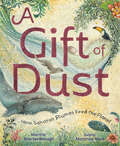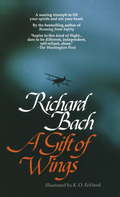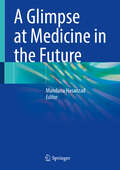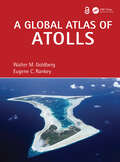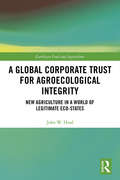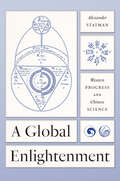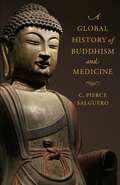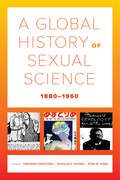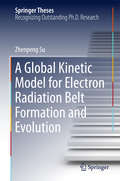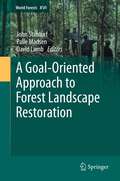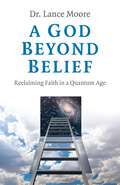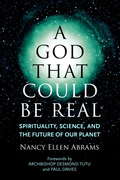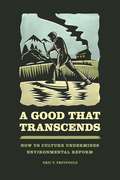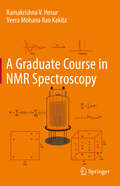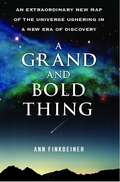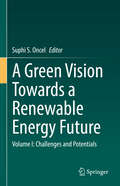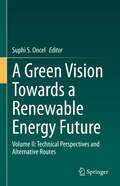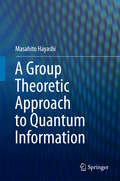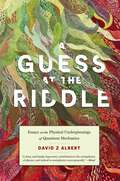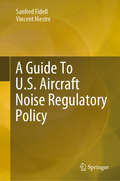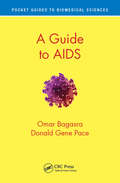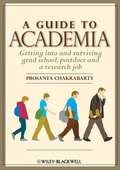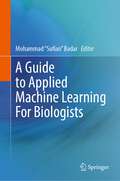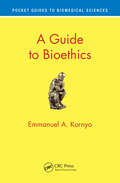- Table View
- List View
A Gift of Dust: How Saharan Plumes Feed the Planet
by Martha BrockenbroughFrom two award-winning creators comes a picture book that reveals the hidden wonders of how Saharan Dust impacts the world: from slowing a hurricane to nourishing a rainforest.This dust . . .of what lived oncesustains what lives today and what will be born . . .tomorrow.An ancient catfish becomes a fossil, and as the lake where it lived dries up, the fossil turns to dust--but this isn't ordinary dust. This dust begins in Chad, West Africa, but winds carry it across the continent, over the Atlantic ocean, to nourish and replenish the Amazon rain forest and beyond. A Gift of Dust takes readers on a journey that shows just how interconnected our planet is, and how something so small can have such a huge impact. With lyrical, awe-inspiring verse based in fact, and stunning art from a Caldecott honoree, this is a story for our times.
A Gift of Wings
by Richard BachOnce in a generation a book, a vision, a writer, capture the imagination and emotions of millions. Jonathan Livingston Seagull was such a book. Richard Bach's unique vision again shines forth, touching with magic the drama of life in all its limitless horizons. Once again Richard Bach has written a masterpiece to help you touch that part of your home that is the sky.
A Glimpse at Medicine in the Future
by Mandana HasanzadThis book covers various aspects of the future of medicine, focusing on innovations in diagnostics, patient care, and drug discovery. With an increasing understanding of the structure and function of the human genome, along with continually improving laboratory and computational technologies, genomics has become progressively integrated into the core of biomedical research, medical practice, and the community. We are at the beginning of a fundamental shift in medicine, moving away from treating disease symptoms and toward curing diseases at their molecular causes. Artificial intelligence will aid in developing individually tailored therapies, gathering and exchanging big data, and advancing telemedicine to bring critical medical expertise to more patients worldwide. The future of medical artificial intelligence looks very promising, demonstrating that artificial intelligence can improve healthcare delivery. The twentieth century saw rapid advancements in disease prevention, including vaccine development and risk-factor prediction and intervention, nearly doubling global life expectancy. Healthcare has already entered the next phase of remarkable progress two decades into the twenty-first century. This book will be useful for health professionals interested in the future of medicine.
A Global Atlas of Atolls
by Walter M. Goldberg Eugene C. RankeyScattered like dots rising from the deep across vast expanses of the world’s tropical and subtropical oceans, atolls with their turquoise lagoons and reefs teeming with colorful marine life have captured the public imagination. They have also been the homeland of millions of people for millennia as various groups of migrants spread across the far reaches if the Pacific, Indian and Western Atlantic regions. Developed from recently available satellite data, A Global Atlas of Atolls presents high-quality details of 476 atolls across the globe, characterizing aspects of the atoll rim, the lagoon, and their coral reef communities in unprecedented detail. In synthesizing and enhancing understanding of these unique seascapes, this volume provides a distinct compendium of descriptions and images, as well as documentation of the environmental conditions of winds, waves, and tides and a summary of the background literature for each atoll area. There is no comparable work.After an introduction that includes a glossary of terms, each atoll is documented in the form of an atlas written for scientists, but accessible to any diver or reader interested in these spectacular reef-island habitats. This book also describes some current challenges and perspectives on their future. It will be useful as a reference work for marine scientists, while providing a minimum of technical jargon for those who are not scientists, but who enjoy reading about exotic places with unusual attributes.Chapter 3 of this book is freely available as a downloadable Open Access PDF at http://www.taylorfrancis.com under a Creative Commons [Attribution-Non Commercial-No Derivatives (CC-BY-NC-ND)] 4.0 license.
A Global Corporate Trust for Agroecological Integrity: New Agriculture in a World of Legitimate Eco-states (Earthscan Food and Agriculture)
by John W. HeadThis book examines global environmental governance and how legal, institutional, and conceptual reform can facilitate a transformation to a new ‘natural-systems’ form of agriculture. Profound global climate disruption makes it essential that we replace our current agricultural system – described in this book as a fossil-carbon-dependent ‘modern extractive agriculture’ – with a natural-systems agriculture featuring perennial grains growing in polycultures, thereby mimicking the natural grassland and forest ecosystems that modern extractive agriculture has largely destroyed. After examining relevant international legal and conceptual foundations (sovereignty, federalism, global governance) and existing international organizations focusing on agriculture, the book explores legal and institutional opportunities to facilitate dramatic agricultural reform and ecological restoration. Among other things, it explains how innovative federalism structures around the world provide patterns for reorienting global environmental governance, including what the book calls eco-states that would, through exercise of pluralistic sovereignty, be responsible for agroecological management. Drawing from his experience working in international institutions, the author provides detailed global-governance proposals for facilitating the type of agricultural reform that can help avoid ecological collapse, especially through soil degradation and climate change. This book will be of great interest to students and scholars of international law, agroecology, climate change, ecological restoration, sustainable development, and global governance, as well as policy-makers and practitioners working in these fields.
A Global Enlightenment: Western Progress and Chinese Science (The Life of Ideas)
by Alexander StatmanA revisionist history of the idea of progress reveals an unknown story about European engagement with Chinese science. The Enlightenment gave rise not only to new ideas of progress but consequential debates about them. Did distant times and places have anything to teach the here and now? Voltaire could believe that they did; Hegel was convinced that they did not. Early philosophes praised Chinese philosophy as an enduring model of reason. Later philosophes rejected it as stuck in the past. Seeking to vindicate ancient knowledge, a group of French statesmen and savants began a conversation with the last great scholar of the Jesuit mission to China. Together, they drew from Chinese learning to challenge the emerging concept of Western advancement. A Global Enlightenment traces this overlooked exchange between China and the West to make compelling claims about the history of progress, notions of European exceptionalism, and European engagement with Chinese science. To tell this story, Alexander Statman focuses on a group of thinkers he terms “orphans of the Enlightenment,” intellectuals who embraced many of their contemporaries’ ideals but valued ancient wisdom. They studied astronomical records, gas balloons, electrical machines, yin-yang cosmology, animal magnetism, and Daoist medicine. And their inquiries helped establish a new approach to the global history of science. Rich with new archival research and fascinating anecdotes, A Global Enlightenment deconstructs two common assumptions about the early to late modern period. Though historians have held that the idea of a mysterious and inscrutable East was inherent in Enlightenment progress theory, Statman argues that it was the orphans of the Enlightenment who put it there: by identifying China as a source of ancient wisdom, they turned it into a foil for scientific development. But while historical consensus supposes that non-Western ideas were banished from European thought over the course of the Enlightenment, Statman finds that Europeans became more interested in Chinese science—as a precursor, then as an antithesis, and finally as an alternative to modernity.
A Global History of Buddhism and Medicine
by C. Pierce SalgueroMedicine, health, and healing have been central to Buddhism since its origins. Long before the global popularity of mindfulness and meditation, Buddhism provided cultures around the world with conceptual tools to understand illness as well as a range of therapies and interventions for care of the sick. Today, Buddhist traditions, healers, and institutions continue to exert a tangible influence on medical care in societies both inside and outside Asia, including in the areas of mental health, biomedicine, and even in responses to the COVID-19 pandemic. However, the global history of the relationship between Buddhism and medicine remains largely untold.This book is a wide-ranging and accessible account of the interplay between Buddhism and medicine over the past two and a half millennia. C. Pierce Salguero traces the intertwining threads linking ideas, practices, and texts from many different times and places. He shows that Buddhism has played a crucial role in cross-cultural medical exchange globally and that Buddhist knowledge formed the nucleus for many types of traditional practices that still thrive today throughout Asia. Although Buddhist medicine has always been embedded in local contexts and differs markedly across cultures, Salguero identifies key patterns that have persisted throughout this long history. This book will be informative and invaluable for scholars, students, and practitioners of both Buddhism and complementary and alternative medicine.
A Global History of Sexual Science, 1880–1960 (California World History Library #26)
by Veronika Fuechtner, Douglas E. Haynes, and Ryan M. JonesStarting in the late nineteenth century, scholars and activists all over the world suddenly began to insist that understandings of sex be based on science. As Japanese and Indian sexologists influenced their German, British, and American counterparts and vice versa, sexuality, modernity, and imaginings of exotified "Others" became intimately linked. The first anthology to provide a worldwide perspective on the birth and development of the field, A Global History of Sexual Science contends that actors outside of Europe—in Asia, Latin America, and Africa—became important interlocutors in debates on prostitution, birth control, and transvestism. Ideas circulated through intellectual exchange, travel, and internationally produced and disseminated publications. Twenty scholars tackle specific issues, including the female orgasm and the criminalization of male homosexuality, to demonstrate how concepts and ideas introduced by sexual scientists gained currency throughout the modern world.
A Global Kinetic Model for Electron Radiation Belt Formation and Evolution (Springer Theses)
by Zhenpeng SuThis thesis focuses on the construction and application of an electron radiation belt kinetic model including various adiabatic and non-adiabatic processes. The terrestrial radiation belt was discovered over 50 years ago and has received a resurgence of interest in recent years. The main drivers of radiation belt research are the fundamental science questions surrounding its complex and dramatic dynamics and particularly its potential hazards posed to space-borne systems. The establishment of physics-based radiation belt models will be able to identify the contributions of various mechanisms, forecast the future radiation belt evolution and then mitigate its adverse space weather effects. Dr. Su is now an Professor works in Department of Geophysics and Planetary Sciences, University of Science and Technology of China, Hefei, China.
A Global Overview of the Conservation of Freshwater Decapod Crustaceans
by Tadashi Kawai Neil CumberlidgeThis book introduces updated information on conservation issues, providing an overview of what is needed to advance the global conservation of freshwater decapods such as freshwater crabs, crayfish, and shrimps. Biodiversity loss in general is highest in organisms that depend on intact freshwater habitats, because freshwater ecosystems worldwide are suffering intense threats from multiple sources. Our understanding of the number and location of threatened species of decapods, and of the nature of their extinction threats has improved greatly in recent years, and has enabled the development of species conservation strategies. This volume focuses on saving threatened species from extinction, and emphasizes the importance of the successful implementation of conservation action plans through cooperation between scientists, conservationists, educators, funding agencies, policy makers, and conservation agencies.
A Goal-Oriented Approach to Forest Landscape Restoration (World Forests #16)
by David Lamb John Stanturf Palle MadsenWhile restoration ecology has traditionally aimed to re-create some putative more 'natural' ecological state, forest landscape restoration (FLR) has emerged over the last decade as an approach aimed more at restoring natural functions, while focusing on meeting human needs. With a view to exploring the practical potential of this approach, this book draws together a team of experts from the natural and social sciences to discuss its success so far in addressing critical issues such as biodiversity, ecological function, and human livelihoods. Applying principles of landscape ecology, restoration ecology, planning theory and conflict management, the book presents a series of case studies which document the approach, and discusses how the approach can help with priority setting for the future. The book will provide a valuable reference to graduate students and researchers interested in ecological restoration, forest ecology and management, as well as to professionals in environmental restoration, natural resource management, conservation, and environmental policy.
A God Beyond Belief: Reclaiming Faith in a Quantum Age
by Lance MooreSomething Has Gone Terribly Wrong… We face a spiritual crisis, but the extremes of religious fundamentalism on one hand, and scientific atheism on the other, offer no cure. Scepticism is soaring, especially among Millennials. Daily, we read of scandals among our politicians, priests and Hollywood stars. Mass shootings are epidemic, yet entertainment media glorifies violence. Drugs, not &“religion&” as Karl Marx claimed, are now the &“opiate of the masses". &“Christian&” TV preachers use donations to purchase private jets and mansions - while children starve. The White House has claimed that &“Truth is not the truth.&” Our leaders and institutions have lost all moral authority. A common religious response to crisis is to thump the Bible harder and louder. This book challenges us to go beyond a simple, childish belief. Dr Lance Moore offers an intelligent faith rooted in a respect for Scripture, while taking a fresh look at calcified orthodoxies. He invites readers to embrace paradox - in Spirituality and in Science - to rediscover God for our Quantum Age.
A God That Could Be Real
by Paul Davies Nancy Abrams Archbishop Desmond TutuA paradigm-shifting blend of science, religion, and philosophy for agnostic, spiritual-but-not-religious, and scientifically minded readers Many people are fed up with the way traditional religion alienates them: too easily it can perpetuate conflict, vilify science, and undermine reason. Nancy Abrams, a philosopher of science, lawyer, and lifelong atheist, is among them. And yet, when she turned to the recovery community to face a personal struggle, she found that imagining a higher power gave her a new freedom. Intellectually, this was quite surprising. Meanwhile her husband, famed astrophysicist Joel Primack, was helping create a new theory of the universe based on dark matter and dark energy, and Abrams was collaborating with him on two books that put the new scientific picture into a social and political context. She wondered, "Could anything actually exist in this strange new universe that is worthy of the name 'God?'" In A God That Could Be Real, Abrams explores a radically new way of thinking about God. She dismantles several common assumptions about God and shows why an omniscient, omnipotent God that created the universe and plans what happens is incompatible with science--but that this doesn't preclude a God that can comfort and empower us. Moving away from traditional arguments for God, Abrams finds something worthy of the name "God" in the new science of emergence: just as a complex ant hill emerges from the collective behavior of individually clueless ants, and just as the global economy emerges from the interactions of billions of individuals' choices, God, she argues, is an "emergent phenomenon" that arises from the staggering complexity of humanity's collective aspirations and is in dialogue with every individual. This God did not create the universe--it created the meaning of the universe. It's not universal--it's planetary. It can't change the world, but it helps us change the world. A God that could be real, Abrams shows us, is what humanity needs to inspire us to collectively cooperate to protect our warming planet and create a long-term civilization.From the Hardcover edition.
A Good That Transcends: How US Culture Undermines Environmental Reform
by Eric T. FreyfogleSince the birth of the modern environmental movement in the 1970s, the United States has witnessed dramatic shifts in social equality, ecological viewpoints, and environmental policy. With these changes has also come an increased popular resistance to environmental reform, but, as Eric T. Freyfogle reveals in this book, that resistance has far deeper roots. Calling upon key environmental voices from the past and present—including Aldo Leopold, Wendell Berry, David Orr, and even Pope Francis in his Encyclical—and exploring core concepts like wilderness and the tragedy of the commons, A Good That Transcends not only unearths the causes of our embedded culture of resistance, but also offers a path forward to true, lasting environmental initiatives. A lawyer by training, with expertise in property rights, Freyfogle uses his legal knowledge to demonstrate that bad land use practices are rooted in the way in which we see the natural world, value it, and understand our place within it. While social and economic factors are important components of our current predicament, it is our culture, he shows, that is driving the reform crisis—and in the face of accelerating environmental change, a change in culture is vital. Drawing upon a diverse array of disciplines from history and philosophy to the life sciences, economics, and literature, Freyfogle seeks better ways for humans to live in nature, helping us to rethink our relationship with the land and craft a new conservation ethic. By confronting our ongoing resistance to reform as well as pointing the way toward a common good, A Good That Transcends enables us to see how we might rise above institutional and cultural challenges, look at environmental problems, appreciate their severity, and both support and participate in reform.
A Graduate Course in NMR Spectroscopy
by Ramakrishna V. Hosur Veera Mohana KakitaThis textbook is designed for graduate students to introduce the basic concepts of Nuclear Magnetic Resonance spectroscopy (NMR), spectral analysis and modern developments such as multidimensional NMR, in reasonable detail and rigor. The book is self-contained, so, a unique textbook in that sense with end of chapter exercises included supported by a solution manual. Some of the advanced topics are included as Appendices for quick reference. Students of chemistry who have some exposure to mathematics and physics will benefit from this book and it will prepare them to pursue research in different branches of Chemistry or Biophysics or Structural Biology.
A Grand and Bold Thing
by Ann K. FinkbeinerLATE IN THE TWENTIETH CENTURY, what had been a fevered pace of discovery in astronomy for many years had slowed. The Hubble Space Telescope continued to produce an astonishing array of images, but the study of the universe was still fractured into domains: measuring the universe's expansion rate, the evolution of galaxies in the early universe, the life and death of stars, the search for extrasolar planets, the quest to understand the nature of the elusive dark matter. So little was understood, still, about so many of the most fundamental questions, foremost among them: What was the overall structure of the universe? Why had stars formed into galaxies, and galaxies into massive clusters? What was needed, thought visionary astronomer Jim Gunn, recently awarded the National Medal of Science, was a massive survey of the sky, a kind of new map of the universe that would be so rich in detail and cover such a wide swath of space, be so grand and bold, that it would allow astronomers to see the big picture in a whole new way. So was born the Sloan Digital Sky Survey, a remarkable undertaking bringing together hundreds of astronomers and launching a new era of supercharged astronomical discovery, an era of "e-science" that has taken astronomy from the lonely mountaintop observatory to the touch of your fingertips. Critically acclaimed science writer Ann Finkbeiner tells the inside story of the Sloan and how it is revolutionizing astronomy. The Sloan stitched together images of deep space taken over the course of five years, providing a remarkably detailed, three-dimensional map of a vast territory of the universe, all digitized and downloadable for easy searching on a personal computer, and available not only to professional astronomers but to the public as well. Bringing together for the first time images of many millions of galaxies--including the massive structure known as the Sloan Great Wall of galaxies, never seen before--the Sloan is allowing astronomers and armchair enthusiasts alike to watch the universe grow up, providing so many discoveries at such a fast pace that, as one astronomer said, it's like drinking out of a fire hose. They are watching galaxies forming and galaxies merging with other galaxies, seeing streams of stars swirling out from galaxies, and forming a new understanding of how the smooth soup of matter that emerged from the Big Bang evolved into the universe as we know it. Ann Finkbeiner brings the excitement and the extraordinary potential of this new era of astronomy vividly to life and allows all readers to understand how they, too, can become part of the discovery process. A Grand and Bold Thing is vital reading for all.
A Green Vision Towards a Renewable Energy Future: Volume I: Challenges and Potentials
by Suphi S. OncelThis 2-volume set provides an overview of the global progress in achieving renewable energy goals through sustainable and economically viable means. Volume I presents the background on renewable energy achievements thus far, and the technological, economic and policy challenges to realizing renewable energy goals. This then leads into a discussion of how a transition to a green economy based on renewable energy could be achieved, including global opportunities, trends, policy considerations and societal implications. The book will appeal to academics, industry professionals and policy makers engaged with the energy economy, renewable energy research and environmental sustainability.
A Green Vision Towards a Renewable Energy Future: Volume II: Technical Perspectives and Alternative Routes
by Suphi S. OncelThis 2-volume set provides an overview of the global progress in achieving renewable energy goals through sustainable and economically viable means. Volume II covers various potential renewable energy sources such as solar, wind, hydro and biomass, including the technologies associated with each that are economically feasible while still being environmentally sustainable in their implementation. This then leads into a discussion of how a transition to a green economy based on renewable energy could be achieved, including global opportunities, trends, policy considerations and societal implications. The book will appeal to academics, industry professionals and policy makers engaged with the energy economy, renewable energy research and environmental sustainability.
A Group Theoretic Approach to Quantum Information
by Masahito HayashiThis book is the first one addressing quantum information from the viewpoint of group symmetry. Quantum systems have a group symmetrical structure. This structure enables to handle systematically quantum information processing. However, there is no other textbook focusing on group symmetry for quantum information although there exist many textbooks for group representation. After the mathematical preparation of quantum information, this book discusses quantum entanglement and its quantification by using group symmetry. Group symmetry drastically simplifies the calculation of several entanglement measures although their calculations are usually very difficult to handle. This book treats optimal information processes including quantum state estimation, quantum state cloning, estimation of group action and quantum channel etc. Usually it is very difficult to derive the optimal quantum information processes without asymptotic setting of these topics. However, group symmetry allows to derive these optimal solutions without assuming the asymptotic setting. Next, this book addresses the quantum error correcting code with the symmetric structure of Weyl-Heisenberg groups. This structure leads to understand the quantum error correcting code systematically. Finally, this book focuses on the quantum universal information protocols by using the group SU(d). This topic can be regarded as a quantum version of the Csiszar-Korner's universal coding theory with the type method. The required mathematical knowledge about group representation is summarized in the companion book, Group Representation for Quantum Theory.
A Guess at the Riddle: Essays on the Physical Underpinnings of Quantum Mechanics
by David Z AlbertFrom the celebrated author of Quantum Mechanics and Experience comes an original and exhilarating attempt at making sense of the strange laws of quantum mechanics.A century ago, a brilliant circle of physicists around Niels Bohr argued that the search for an objective, realistic, and mechanical picture of the inner workings of the atom—the kind of picture that had previously been an ideal of classical physics—was doomed to fail. Today, there is widespread agreement among philosophers and physicists that those arguments were wrong. However, the question of what that picture might look like, and how it might fit into a comprehensive picture of physical reality, remains unsettled.In A Guess at the Riddle, philosopher David Z Albert argues that the distinctively strange features of quantum mechanics begin to make sense once we conceive of the wave function, vibrating and evolving in high-dimensional space, as the concrete, fundamental physical “stuff” of the universe. Starting with simple mechanical models, Albert methodically constructs the defining features of quantum mechanics from scratch. He shows how the entire history of our familiar, three-dimensional universe can be discerned in the wave function’s intricate pattern of ripples and whorls. A major new work in the foundations of physics, A Guess at the Riddle is poised to transform our understanding of the basic architecture of the universe.
A Guide To U.S. Aircraft Noise Regulatory Policy (Springerbriefs In Applied Sciences And Technology Ser.)
by Sanford Fidell Vincent MestreAviation noise remains the primary hindrance to expansion of airport and airspace capacity in the United States. This book describes the development and practice of U.S. aircraft noise regulation, as well as the practical consequences of regulatory policy. Starting in the pre-jet transport era, the book traces the development of the modern framework for characterizing, standardizing, predicting, disclosing, and mitigating aircraft noise and its effects on airport-vicinity communities. Among other matters, the book treats noise-related consequences of the 1978 deregulation of the airline industry; prediction and mitigation of community reaction to airport noise; land use compatibility planning; recent research and industry trends; and some suggestions for potential improvements to current policy. Initial chapters describe the assumptions underlying aircraft noise regulation, and lay out the chronology of U.S. aircraft noise regulatory practice. Later chapters provide overviews of population-level effects of aviation noise, including health effects, speech and sleep interference, and annoyance. Readers will learn why predictions of the prevalence of aircraft noise-induced annoyance have systematically underestimated adverse community response to aircraft noise, and how such underestimation has complicated approval and funding of airport and airspace improvement projects. They will also learn why attempts at noise-compatible land use planning are seldom fully successful.
A Guide to AIDS (Pocket Guides to Biomedical Sciences)
by Omar Bagasra Donald Gene PaceThe Guide to AIDS is succinct review of HIV/AIDS from a human-interest perspective. Chapters focus on some of the common patterns and prevention of HIV transmission and debunks misconceptions about HIV and AIDS. Brief descriptions the human immune system and epidemiology of HIV are included. The cultural component of disease, treatment and living with AIDS is central to much of this guide intended to synthesize, explain and de-mystify HIV and AIDS.
A Guide to Academia: Getting into and Surviving Grad School, Postdocs, and a Research Job
by Prosanta ChakrabartyA Guide to Academia is a handbook for all those individuals thinking seriously about going to graduate school. Written by an author with extensive experience navigating the academic world, the book explains all the steps and potential bumps in the road that a student might encounter as they take the plunge into academia. Each chapter begins with a section called the "hard truth," which will help students determine if they are on the right path. Starting with an undergraduate student looking for a graduate school, the reader is taken on a journey up the academic ladder through graduate studies, a postdoctoral fellowship and an assistant professorship. Each chapter gives advice on not only how to survive the current stage but how to get to the next stage quickly. Enhanced with material from the author's own job applications and interview presentations, A Guide to Academia provides concrete examples of the tools needed for a successful career in academia.
A Guide to Applied Machine Learning for Biologists
by Mohammad “Sufian” BadarThis textbook is an introductory guide to applied machine learning, specifically for biology students. It familiarizes biology students with the basics of modern computer science and mathematics and emphasizes the real-world applications of these subjects. The chapters give an overview of computer systems and programming languages to establish a basic understanding of the important concepts in computer systems. Readers are introduced to machine learning and artificial intelligence in the field of bioinformatics, connecting these applications to systems biology, biological data analysis and predictions, and healthcare diagnosis and treatment. This book offers a necessary foundation for more advanced computer-based technologies used in biology, employing case studies, real-world issues, and various examples to guide the reader from the basic prerequisites to machine learning and its applications.
A Guide to Bioethics (Pocket Guides to Biomedical Sciences)
by Emmanuel A. KornyoSolving intractable biotechnological questions of evolution, medicine, and genetics is now easier due to methods permitting the rapid analysis of molecular sequence data. These advances have exposed ethical and policy concerns. How would genomic information be used and by whom? Should individuals be able to make decisions regarding their own genomic data? How accurate are these genetic tests and how should they be regulated? These and other ethical conundrums are the subject of this book. Bioethicists, biomedical policy experts and lawyers, physicians, nursing and allied health students as well as science educators will find this book helpful and engaging in exploring the complexities of modern evolutionary, genetic and biomedical data.
